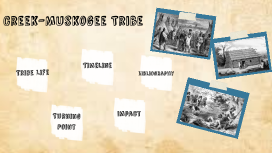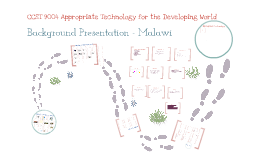Creek Presentation
Transcript: Creek-Muskogee Tribe Tribe Life Tribe The Creek people lived in houses arranged around a village square. Creek houses were made of plaster and river cane walls. The English called the Muskogee Native Americans "Creek", probably due to the large amount of rivers, creeks, and streams around their lands. The Creek Native American tribe is descended from ancestors from as long ago as 1500 AD! The Creek tribe was many different tribes under the same union. The general name they went by was just Creek-or Muskogee. The Creek children liked to hunt and fish with their fathers, play with wooden toys and toys made out of crops, and normally the girls would make baskets or learn to cook. Food/Resources Food Resources The Creek people had quite a few natural resources. They had quick and easy access to water, crops, and wood. They lived very close to rivers, streams, and creeks. (Hence the name). They also lived near forests. They had many large crop fields. The Creek people fished and hunted, but were most commonly known for farming. The women usually farmed while the men hunted and defended the villages. The crops that they ate commonly consisted of corn, beans, and squash. The tribe also ate wild turkeys, deer, and small animals. Some of the food that they made includes cornbread, soups, and stews. Jobs/Tasks Popular Creek Jobs Creek Fisher/Hunter Creek Farmer Creek Warrior Problems Start to arise.. Turning Point President Andrew Jackson passed the Indian Removal Act in 1830. The Creek Tribe did not give up their land easily. They rejected the idea several times, until they were pushed to the point of war. Around 1836, most of the Creek Tribes had either willingly relocated or had been forced to relocate. Battles Battles The Creek Tribe fought back against the Indian Removal Act. The first Creek War began in 1813 and continued until 1814. It was caused by the Red Sticks-A group of more violent Creeks- ambushing a large group of American Frontiersmen that were near one of the Creek villages. Andrew Jackson gathered around 5,000 militiamen and fought the Creek Native Americans. The Creeks were largely outnumbered, and lost. The second Creek war was fought through the spring of 1836. Cotton was becoming very popular, and so people had started planting cotton fields on Creek territory, without the tribe's consent. The Creeks got angry and tried to fight the Americans, but lost. The Americans had more troops, more resources, and more modernized weapons. Removal Removal On the Trail Of Tears, out of the 22,000 Creeks that traveled, only about half made it to Oklahoma. The conditions on the trail were harsh. Winter was freezing, summer was blazing, and they were constantly walking. They walked over 1,200-2,200 miles for many long months. The Creeks were malnourished and tired. Many Creeks died from disease, as they were exposed to many new and different sicknesses on the trail. Creek Timeline Timeline 800-1500 AD Andrew Jackson passes the Indian Removal Act. Many Creeks protest, but some peacefully start on the long journey to Oklahoma. The Trail Of Tears. Creeks walk 1,200-2,100 miles on the trail. The walk took about 6 months. The Creek Tribe is formed. The Creek people are descended from the Mississippian people. Forced Removal. The United States has started to force Creeks out of their homes and onto the trail. By 1836, most of the Creek tribe has either moved peacefully or forced out. The Creek War. The Creeks lost against the United States. Unfortunately, the Creeks lost quite a bit of land because of this. The Creek Tribe is currently residing in Oklahoma. There is around 44,000 members. 1813-1814 1830 1831-1877 1830-1836 1877-Present day Impact/Aftermath Impact The Creek Tribe suffered greatly on the Trail Of Tears. Around 3,500 Creeks died on the journey. When they arrived in Oklahoma, they had to start all over and made houses, villages, and more. Many of their population had passed away, so they were left with not many workers to build and farm. When they got to Oklahoma, many of the Creeks were weak and malnourished. This made it hard to settle down and survive. Eventually, Creek villages were created and farms were fertilized. Bibliography Bibliography Source 1: https://pci-nsn.gov/wordpress/about/history/ Source 2: http://www.bigorrin.org/creek_kids.htm Source 3: https://www.muscogeenation.com/culturehistory/ Source 4: https://www.britannica.com/topic/Creek-people

















